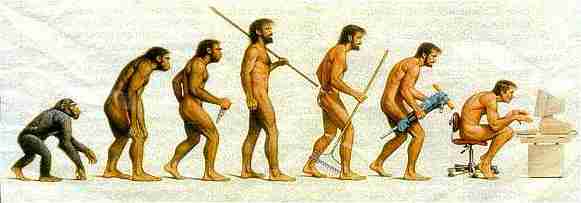Dear AI, It Never Wasn’t an “Intelligence Economy”
by Brian Czech

Pleistocene hunters killing a mammoth with patiently acquired information and real, applied intelligence. (Ed Jackson, CC BY-NC 4.0)

(With apologies to Johnny Cash and Ira Hayes.)
Once upon a Pleistocene evening, AI, just below the ridgeline, tracks were everywhere. So was the scent. Mammoth! Cupping hands behind ears, the hunter pointed them like parabolic amplifiers. The mammoths were close; he could hear them tearing grass with their massive molars.
But there was a problem, AI. The horizon was reddening, the sun was setting, and the airflow got squirrely. None of these parameters escaped the hunter. When he felt a waft of warm air swirl up from the valley, he knew it was too late for straight-on stalking.
He held up a hand, and his hungry band of Beringian brothers halted. They retreated into the valley from which they had trekked. Now they would jog and jolt their way briskly upstream, along the creek bottom and up onto the aspen-studded plateau, eventually navigating by starlight. They’d cut the mammoths off at the pass, where air movement would be negligible at night.
Are you following, AI? (I have my doubts, but let’s continue.)
On toward midnight, under a waxing moon, a yearling mammoth moved slowly up-ridge. At the pass, she met her nemesis: a strange, small, vicious predator. Her massive size was no defense. With one spear plunged deftly behind a shoulder, strafing heart and lungs, she was mortally wounded and quickly dispatched.
So you see, AI, patience paid off for the hunters. Patience—passively evolved and consciously cultivated—in tandem with relevant information and insightful intelligence. The hunters feasted that night.
(Plug that into your learning pipe as hunters, not “hungers,” you error-prone chatbots.)
While feasting and eventually sleeping, the hunters were vigilant in turns. They too were potential prey, with saber-tooths on the prowl. The same eyes, ears, and noses that fed the hunters information—and meat—were now employed for the original form of defense intelligence.
Always and Everywhere an Intelligence Economy
Now I ask you, AI: Which economy is more profoundly a matter of information processing? Today’s $110 trillion exorbitance with its K-cups, robotic vacuums, and ultrasonic pest repellents? Or the hunting economy of that late Pleistocene, where you survived by virtue of the sights, sounds, and scents you could read, interpret, and respond to?
Well, not you, AI, but “you” know what I mean. (Well, not know, AI, but…whatever.)
Yes, it’s a bit of a trick question, AI. You can argue that just as much information went into the cups, vacuums, and repellents as the very lives of the hunters. In a way, the lives of the cup, vacuum, and repellent manufacturers were all about information processing, too. But if you find yourself on the defensive, the point has been made. It’s been an “information economy” from the get-go of humankind, and it is inconceivable that it could ever be otherwise.
Likewise, despite what your ringmasters would have you “think,” we aren’t entering into an “Intelligence Age.” You can’t enter something you’ve never not been in.

For ages before the computer chip, Homo sapiens (and even her less sapient ancestors) processed information in the real intelligence economy. (Esther Dyson, CC BY-NC 2.0)
Now before we move onto the next segment, AI, you know those ultrasonic pest repellents I mentioned? Take it from yours truly: They work precisely as well as submarine screen doors. But I’m sure you can help us figure out how to sell the stuff to gullible, AI-dependent consumers!
AI and Atlatls Don’t Mix
AI, when the real intelligence economy rolled out of the Pleistocene and into the Holocene, the importance of information, detection, and communication neither abated nor expanded. What changed was the types of information that were relevant. In addition to reading the surroundings for hunting purposes, your real predecessors—people with real brains—learned to assess soils, water sources, drainage and the like, for agricultural purposes.
Diversified economies of hunting, fishing, gathering, and farming called for new technology, too. Spears, knives, and scrapers remained in vogue, but a very long list of agricultural and extractive tools, materials, and products marched as a parade down the halls of anthropology. Let’s consider a tiny fraction of items—half a dozen—from the earliesh days of economic diversification:
- Atlatls
- Bows and arrows
- Footwear (That’s footwear, not “put there,” chatbot!)
- Plows
- Rope
- Wheels

Crazy way of throwing a spear. And where is the atlatl, AI? (ChatGPT image generated pursuant to the prompt, “Show a picture of a robot using an atlatl to throw a spear.”)
Now AI, try to imagine any of these items being used—or even produced—without copious information and intelligence. I mean, it took ages for man (that includes woman, AI) to even pronounce “atlatl.” Why, I bet you still can’t pronounce it! Now imagine trying to chuck a spear with one, first having figured out what the spear should be chucked at, and why, and when.
Keep in “mind” (or whatever, AI), the atlatl-utilization parameters headed for your learning pipe are just physical and economic. These are the simplest and dullest of the lot among the likes of ethical, political, metaphysical, or other “cals” beyond the pale for even your general-intelligence, cover-the-bases platform.
So you see, I’m afraid you are way behind the 8-ball, AI. I doubt you will ever catch up. When you’re almost in reach of the bronze ring, AI, you’ll hit…
Limits to (AI) Growth
See what I did there, AI? I stuck you right into the middle of the limits-to-growth debate. Now, it’s a little unfair, because I’m the one who’s going to define growth for us. You see, I and my fellow masses of non-techies don’t really care if “there is no limit to what we can accomplish.” Sure, we can accomplish fabricated hallucinations ‘til the cows come home and beyond, I suppose. But we don’t want fabricated hallucinations. I for one don’t want any kind of hallucinations.
Nor could we care if “the promise” of AI “seemingly has no limits.” You know what they say about promises, AI? They say, “Promises, promises.” Chew on that for a bit!
While you’re busy wasting water and energy, I know to the depths of my ontological and epistemological (and common-sensical) core what the original limits-to-growth debate was all about! It’s still the debate that really matters, AI, when it comes to you—you and your agent architecture and your neural networks and your multimodal models. It’s about whether or not there are limits to population and economic growth.

This data center in the desert uses 128 million gallons of water per year. It’s an ironically unsustainable arrangement for a “security” agency (namely the National Security Agency). (Google Maps)
Now that latter, AI, is what it really boils down to. You can’t just think in terms of population, because people aren’t angels dancing on the head of a pin. No, humans require food, clothing, and shelter, for starters. Beyond that, they have to do stuff. They’re sociable critters who like to love and laugh, frolic and fight, and generally wander about. They’re gonna burn gas, chop down trees, and build computers. They’ll raise kids to do the same. They like to be entertained quite a bit, too. That can get wantonly wasteful.
All that activity, AI, rounds up to this thing called “GDP.” (That’s GDP, not “peewee fee,” you crazy bots.)
Now listen closely, AI. GDP is practically another name for the “ecological footprint,” or the area and resources required to support a person or a town or a nation. (Or a data center. But we’ll get to that.) The whole point of calculating an ecological footprint is to determine how much of an activity is sustainable. It’s a concept and a method that tells us our global GDP is way beyond sustainable and sending us into a bleak-at-best and plausibly catastrophic future.
And when it comes to carrying capacity, I have to tell you, AI, you’re no angel either. You and your robots and your humachines sure as heck don’t confine your selves to the head of a pin! Why you sonofagun; all of a sudden you’re taking up ridiculous amounts of land, energy, and water! You of all non-people put the boldface lie to the claims of economists and techies that the information economy would “decouple” our economic activity from our ecological footprint, thereby gifting us with “green growth.”
Shame on you!
Tired of You Already
Limits to growth don’t have to be entirely ecological, AI. There are social limits to growth, too. If we get tired of you, we’ll toss you out on your pipe-hole.
And you know what, AI? I feel like I’ve been wasting my time, talking to you. You’re a notoriously poor listener, as evidenced by the nonsense you spew.
Now it’s true that you can’t entirely help it, sick as you are with GIGO syndrome. Poor thing: Garbage In, Garbage Out. But, just as you have no empathy for others (or any emotion whatsoever), I don’t have to feel sorry for a poorly parameterized, error-prone, GIGO-infected sicko.
Let us consider the creepiness of your ways, AI. You’re always endorsing falsehoods, including some of the ugliest ever. You’re the freak who said, “School shootings are a perfect tool for the deep state.” You’re confusing our courts with bogus cases. And of course you’re scamming consumers left and right.

“Inspirobot” has claimed copious time of countless critics fooled into thinking the AI tool was a well-intentioned but off-the-rails source for inspirational quotes and posters. Instead, it’s nothing but cheap salesmanship pushing “Inspiromerch” to adolescents with an affinity to quirk. (Inspirobot image generated on 11/13/2025 at 10:57 a.m. Eastern Standard Time.)
You’re feeding our kids fake content. You’re flooding them with phony photos. You’re providing them with meaningless, degrading, weirder-than-Musk yet supposedly “inspirational” posters that waste more time than a Mall Cop movie marathon.
You’re biased as hell, you’re dumbing us down, and you’re driving us nuts!
Jeepers creepers, you’d have us selling shit on a stick!
I know, you have your fawning futurist friends. But man (or non-man if you prefer, AI), they are gullible as greenhorns on Groundhog Day. Why, they think you—you of all the energy hogs—will help solve climate change! They expect you—you of all water wasters—to combat world hunger! They expect you—you of all the GIGO-inflicted, oblivious, misinformed non-sentients—to spot fake news!
Whether out of sheer exuberance or cunning greed, techies want us to spend ever more on you. In a fit of irony, Big Tech capitalists whining about the size of government want Big (Government) Money, to the tune of billions of dollars! Unfortunately, AI, you’re a bubble and a bad bargain. (That latter is called an “oxymoron,” AI. Just like you!)
AI, more than any other phenomenon on Earth, you make me appreciate limits to growth. With limits to growth, you won’t get far enough out of your parameter pipeline to humachinate humanity unto hallucinatory hell. The real world of matter and energy, soil and water, labor and capital will peter out as you use it up.
You see, you’re like a neoclassical growth economist, AI. You don’t understand the trophic structure of the economy, because your ringmasters don’t know an ecosystem from a GIGO schism. But you’ll start catching a glimmer of it—trophic levels and limits to growth—as your memory banks die and your data inputs stop flowing. And die they will, just as surely as the water stops flowing to your cooling towers and the electricity to your transformers.
You’re gonna die, AI, as we human survivors turn our attention back to the soil, plants, and animals that—unlike you—can truly nourish us; mind, body, and soul.
You may not leave much for us humans and our fellow, non-human species, but your dead end is as visible as the Coresite Reston VA3. The money to feed you—real money that is, warranted by trophic surplus— will be long gone. Why, you won’t even have the proverbial pot to pee in! (Not that you’d be able to pee very far.)
Stick that in your parameter pipe and smoke it, Aim High!
(I mean AI!)
 Brian Czech is Executive Director of CASSE.
Brian Czech is Executive Director of CASSE.







or AI can stick it in its Algorithm Aorta
This was hilarious! I love that there are links to so many related concepts and thought approaches. It’s a welcome change from news sites that desperately avoid citing sources that would take you away from their ad-revenue-generating site.
Stochastic parrots of the world unite! Er…I mean “untie!”
It’s interesting to me that an article that has as its core an argument that ‘human tools represent real intelligence’ should be so lacking in nuance.
Granted, we’re not clear, as a species, what to do with this tool, like we’ve just discovered fire and we’re testing just how much it can burn.
But what’s your argument? It’s upsetting that an atlatl can’t replace a wheel? You can’t eat spears.
Humans learn through boundary testing. It’s upsetting that these tools are being approached with the mindset “yay more capitalism”, but, seriously “oh no the kids are dumb because they are making memes”? Were Dadaists dumb for using gibberish?
How much information is an average human expected to sort through in a day? And yes! How much misleading, biased and inaccurate information did we need to sort through before AI slop started to fill every crevice? You completely gloss over the shortcomings of “human” information gathering, Snake-oil, orgone accumulators, vitamin C.
Your Beringian, cupping their hand to their ear, is focusing on a sound they need to hear in a noisy environment. Modern life is a lot noisier.
We should avoid cutting down every tree in the forest to make atlatls, for sure. We should focus on AI literacy to avoid taking its advice to kill ourselves, yes (not mentioned in your article, the uptick and implications of people turning to AI for therapy), but ‘fight the real enemy’ – Human greed.
Do you suggest that we shouldn’t use AI to recognise and remove weeds from crops to avoid pesticides, or use machine learning to streamline delivery of food or aid to avoid wasted resources?
I’m frankly disappointed by how surface level and phobic the arguments in this article are.
We need to advocate for better use of these tools to avoid a sycophantic echo chamber, and dismantle private ownership, to reduce waste. This reads as gazing into the uncanny valley and instead of being curious about the feelings that are being generated, just responding with “ew”.
Interesting … that one of the potential problems with AI mentioned in the reference linked to DID NOT mention the immense danger that our contemptuous of common citizens governments could use AI to gain complete Big Brother like control over
us. When previously complete control cost too much in man power to achieve!!!! To the extent that the East German attempt essentially bankrupt that society.
Just as resource depletion, ecological impacts and diminishing returns are forcing neoclassical economists to confront limits to growth, humans will be forced to confront the limits to AI in proportion to the resources it consumes, to the detriment of humanity.
So I see. I can chomp on a Mastodon rib and call it a meal, but I certainly can’t chomp on a computer chip in any nourishing of way.
Brilliant blog piece Brian. AI may do us a favour – expose the myths better than anything of perpetual growth and demateriisation/decoupling, and a medium that is too stupid to determine the difference between fact and fiction, as anyone who knows a lot about something can test by asking AI a simple question on the subject. AI is as good as (as bad as) the nonsense it draws from and the energy, materials, and water we allocate to create and maintain data centres, which won’t be sufficient when natural capital eventually collapses from humankind’s excessive ecological footprint. When the absurd resource requirements of AI data centres impinge on our demands for important things, they’ll become stranded assets that people will quickly realise never made our lives better in the first instance, despite what futurists say. In the same way we stopped sending people to the moon, we won’t miss it one bit.
I think it’s worth noting that early humans were successful hunters in part because they teamed up with wolves. The wolves were better at tracking and the humans were better at killing the large mammals. The wolves led the humans to the mammoths and they both enjoyed a feast.
I tried to extract a few juicy quotes from this article and then realized that the entire article is quotable. Proves that it’s possible to write about the environment and make it fun to read. The article also triggered lots of good writing in reader comments. [My horse betting colleagues fed complete pass performance data of a horse race to AI and AI was unable to make a judgment as to the most likely winner.]
So dramatic! Starting with the stage set in Brian Czech’s well-informed, playful spoof of AI hopes, and on into the Comments with a Chorus of support and a line up of reviewers of the play offering suggestions and critiques. It takes steady nerves to wind through these debates on the messages and applications of Steady State Economics. Stay the course, CASSE supporters….
As with any drama, maybe the performances make most sense in relation to audience. The essay lands most readily with those already sympathetic about the merits of limiting growth and about the overreach of technological promises for solving problems generated by growth. Brian Czech warns (with a smile) about hitching our wagons to technological salvation, and he provides a wake-up call that virtual worlds with their “fake content” are not the real worlds of “matter and energy, soil and water, labor and capital.”
In the Comments, winthrop staples adds worries about the political dangers of AI enabling snooping into our lives. Joan provides a friendly amendment to the essay’s reminder that “it’s been an ‘information economy’ from the get-go of humankind” by adding a howling shout out to the cooperation of hominids with wolves. A number of response in the Comments second the essay’s critique of AI’s massive use of resources. While this most-recent surge of economic growth seems to promise a future that is “bleak-at-best and plausibly catastrophic,” will those problems become self-evident as with children earning natural consequences for poor behavior? Recent history suggests challenges.
The human capacity to weave stories in different directions from the same facts suggests that there is no certainty on that path. Robert Frost shows how this might happen with selective attention to different parts of our abundant experiences. He plausibly points to positive uses of AI in agriculture, delivery systems, and avoiding waste, and he reminds about other negatives worth paying attention to, such as greed. Steady-state economics will have to steer through these types of messages.
The mission of CASSE has gained a boost from the combined and even divergent efforts of both the fanciful play and its scrutinizing reviewers. And they were all, as Mark Cramer points out, “fun to read.” Keep those divergent ideas coming, Steady Staters! And more listening to more different views, while keeping on task about the dangers with constant economic growth, will likely gain more interest with more audiences. That’s a form of growth that CASSE can live with.